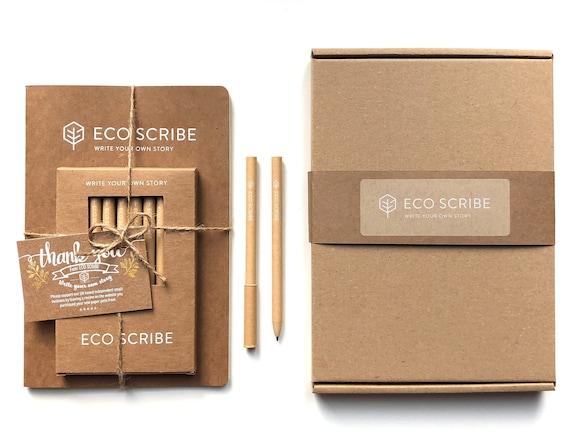In a world where creativity and sustainability are frequently enough seen as opposing forces, the rise of recycled stationery offers a refreshing way to bridge that divide. As artists, writers, and everyday note-takers seek to express their thoughts and ideas, they are increasingly embracing products that not only fuel their creativity but also tread lightly on the planet. “Recycled Stationery: Writing and Drawing with a Lighter Footprint” invites you to explore the innovative materials and designs reshaping the stationery landscape. From notebooks crafted from post-consumer waste to pencils made from recycled wood,these eco-friendly alternatives challenge the notion that you must sacrifice quality for sustainability. Join us as we delve into the myriad options available for the conscious creator, celebrating the beauty of self-expression while championing a greener future.
Exploring the Eco-Friendly Materials Behind Recycled Stationery
In the realm of recycled stationery, a multitude of eco-friendly materials come together to create products that are not only functional but also sustainable. The cornerstone of these materials is post-consumer waste, which includes anything from scraps of paper and cardboard to discarded packaging. By breathing new life into these materials, manufacturers can significantly reduce the need for virgin resources. some commonly utilized materials in recycled stationery include:
- Recycled Paper: Made from used paper products, this material maintains quality while minimizing environmental impact.
- Plant-Based Inks: Utilizing vegetable or soy-based inks helps lessen harmful emissions compared to conventional petroleum-based inks.
- Biodegradable plastics: Derived from natural sources, these plastics break down more easily than conventional ones, reducing landfill waste.
Additionally,the selection of these materials is ofen enriched by innovative blends and hybrid solutions that enhance durability and aesthetic appeal. As a notable example, some stationery makers are exploring the use of agricultural waste, such as rice husks or sugarcane bagasse, to produce textured papers that look and feel unique. In the table below, you can see a comparison of the environmental benefits associated with diffrent eco-friendly materials:
| Material | environmental Benefit |
|---|---|
| Recycled Paper | Reduces deforestation and energy usage. |
| Plant-Based Inks | Minimizes harmful emissions and pollutant discharge. |
| Biodegradable Plastics | Reduces persistence in landfills. |
| Agricultural Waste Papers | Utilizes waste that woudl otherwise contribute to pollution. |

Innovative Brands Leading the Charge for Sustainable Writing Tools
Across the globe, a wave of visionary brands is reshaping the landscape of writing tools, demonstrating that sustainability can seamlessly blend with creativity. these companies are pioneering the use of recycled materials in their products, from pens made from reclaimed plastics to notebooks crafted from post-consumer waste. By prioritizing eco-friendly practices, they not only reduce their environmental impact but also encourage consumers to make conscious choices about their stationery. Notable brands pushing the envelope include:
- EcoPen: Utilizes recycled aluminum and biodegradable inks.
- TreeSmart: Creates pencils from recycled newspaper, eliminating the need for wood.
- Paper On paper: Offers 100% recycled paper products adorned with lovely designs.
- Swell: Develops reusable notebooks that allow for endless creativity without waste.
These innovative companies have not only introduced eco-conscious products but also fostered a movement toward sustainable habits among artists, students, and professionals alike. The transition from conventional materials to recycled alternatives is increasingly apparent in classrooms and workplaces,highlighting the demand for more sustainable practices across various sectors. Consider weekly usage comparisons for traditional vs. sustainable products:
| Product Type | traditional Options | Sustainable Alternatives |
|---|---|---|
| Pens | Single-use plastic | Recycled plastic pens |
| Notebooks | Newly produced paper | 100% recycled paper notebooks |
| Pencils | wooden pencils | Newspaper pencils |

Creative Ways to Incorporate Recycled Stationery into Your Daily Life
Transforming your daily routine with recycled stationery not only enhances creativity but also promotes sustainability.Consider creating a gratitude journal using repurposed paper scraps; each entry can be a delightful canvas for doodles or positive affirmations. You can also craft your own customized gift tags from old postcards or gently used wrapping paper, adding a unique touch to your gifts while minimizing waste. reclaimed envelopes can be creatively cut and decorated to form mini-notebooks for swift notes or sketches on the go, ensuring you always have a creative outlet at hand.
Incorporating recycled stationery into your workspace adds a personal flair and encourages eco-conscious habits. Create a vision board using vibrant pages from magazines destined for the recycling bin, sparking inspiration while showcasing your goals and dreams. Organize your thoughts with stationery-based institution by using colored paper clips, old business cards, or even fabric scraps to label and categorize items in your workspace. Check out the simple table below for more fun ideas:
| Activity | Materials Needed | Benefits |
|---|---|---|
| Gratitude Journal | Scraps of paper, binding string | Promotes positivity |
| Custom Gift Tags | Old postcards, scissors | Unique gifting |
| Vision Board | old magazines, glue | Goal visualization |
| Mini-Notebooks | Old envelopes, markers | Quick notes |

Benefits of Choosing Recycled Products for the Environment and Your Creativity
Embracing recycled products in your creative pursuits not only supports the planet but also enhances your artistic expression. By choosing recycled stationery,artists and writers alike can engage with materials that carry a story and a purpose. Each page of recycled paper is a testament to the transformative power of reuse, allowing you to make a tangible statement about sustainability while channeling your inventiveness. Consider the various advantages:
- Minimized Waste: Utilizing recycled materials contributes to a reduction in landfill overflow.
- Resource Conservation: Less energy and fewer trees are needed to produce recycled paper compared to virgin paper.
- Unique aesthetic: Recycled products often boast distinctive textures and colors that can inspire creativity.
- Informed Choices: Using recycled materials encourages mindfulness about consumption and inspires others to follow suit.
Furthermore, opting for recycled stationery can spark innovative ideas that integrate sustainability into your creative endeavors. Whether you’re sketching, journaling, or crafting cards, the use of recycled products can open a dialog about environmental consciousness and artistic ingenuity. here’s a quick look at different recycled stationery options and their artistic benefits:
| Type of Recycled Stationery | Creative Benefit |
|---|---|
| Recycled Notebooks | Perfect for journaling with a textured finish that inspires deeper writing. |
| Recycled Sketch Papers | Provides unique tooth for pencil and charcoal, enhancing drawing experience. |
| Recycled Greeting Cards | Offers a unique canvas for personalized designs, supporting eco-friendly messages. |
Final Thoughts
As we tighten our grip on the pen and unleash our creativity, let’s not forget the unsung heroes behind our ink and paper — the recycled materials that breathe new life into what was once discarded.By choosing recycled stationery, we are not only nurturing our artistic expressions but also nurturing our planet. Each stroke we make on these pages contributes to a greener future, proving that our choices can resonate far beyond the confines of our workspace.
So, the next time you reach for a notebook or sketchpad, consider the journey of those materials. With every word penned and every line drawn, let your creations echo the values of sustainability and responsible living. In our quest for creativity, may we leave a lighter footprint on the Earth, showing that art and environmental stewardship can go hand in hand. Here’s to a world where every creation tells a story — not just of inspiration, but also of respect for our beautiful planet.Happy writing and drawing!




